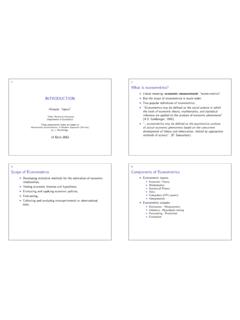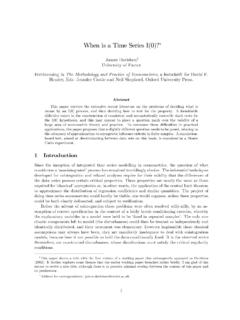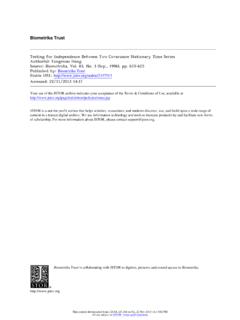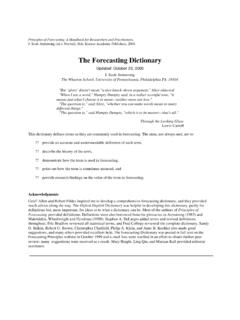Transcription of A compendium of existing econometric software …
1 Journal of Economic and Social Measurement 29 (2004) 359 409359 IOS PressA compendium of existing econometric softwarepackagesEdited by Charles G. Renfro601 West 113th Street, #12G, New York, NY 10025, USAE-mail: compendium of existing econometric software packages is intended to be a full census of allexisting packages of this type that are publicly available and used by economists today. It is intended toprovide the developer s view of each package: in all but a few instances, the person providing each entryis the primary author or current principal developer of the package. These program descriptions generallyprovide both a development history and a statement of current capabilities.
2 Most entries also includereferences to more detailed descriptions, including manuals and other publications, as well as providing awebsite IntroductionThis document is a supplement to the introductory article of this volume, Econo-metric software : The first fifty years in perspective . As that article began to bewritten, it quickly became evident that it would not and could not provide a balancedand reasonably comprehensive description of each of the currently available econo-metric software packages , both because of its author s lack of direct knowledge ofthe history, features and capabilities of every package and because no ready referenceexisted that provided such documentation.
3 Consequently, it seemed sensible to try toprovide separately, in the form of this compendium , a document that could generallyserve as a public reference and at the same time provide a statement of the state ofthe art in the year first step taken was to contact the authors or developers of each of the softwarepackages currently listed on the American Economics Association s Resources forEconomists on the Internet ( ) asking first if the software they providedmet the criterion of being econometric software and, if so, then asking them to providea description. Subsequently, by word of mouth, as well as by recommendation,additional packages were discovered.
4 In every case that a package was found that hassubsequently been identified by its author or developer(s) as being an econometricsoftware package, an entry has been provided and is included. It does not appear thatany developer has refused to submit a package inclusion, the criterion applied has been that the package is primarily econo-metric in its features and capabilities. As a consequence, there are packages that areused by economists, but identify themselves as being primarily statistical softwarepackages, or some other type of software package, and therefore are not $ 2004 IOS Press and the authors. All rights Renfro / A compendium of existing econometric software packagesOf course, it is inevitable that one or more packages have been omitted that willsubsequently be identified as econometric software packages , but the intention hasalways been to include every such publicly available package as of 1 June 2003.
5 Tothis end, drafts of this compendium have been circulated widely during the past sixmonths and of the econometric software packages represented is described in somedetail and in a roughly consistent style. As an editorial intention, each descriptionidentifies the principal author(s), provides brief historical information, and describesthe program s salient characteristics. As a rule, the descriptions were providedby the principal, often original author(s) of the program or, in a few cases, theprincipal current developer, and have simply been edited for style. One of thepurposes in the creation of this document is to provide both descriptions of packagesand a clear statement of each package s development history, which may includethe range of machines the software has been mounted on during its life, as wellas operating systems under which the software runs or has run historically.
6 In afew cases particularly when a package is important historically, but is no longersupported a description of it and its history has been independently provided,usually in cooperation with former and, in some cases, current users of the context in which each package is presented depends on its available packages are classified into four categories: Independent Econo-metric software packages , econometric Programming Libraries, econometric andMathematical Programming Languages, and Applications of econometric and Math-ematical Programming Languages. A fifth category consists of packages that are ofhistorical interest, but are no longer supported.
7 This classification scheme is notideal, but it is difficult to determine how else to qualificationAs indicated earlier, the packages included here have not been, in any way, vet-ted. Dates of original release and subsequent modification should be interpreted asrepresenting developers claims. Similarly, all claims that a particular package per-forms some particular operation should be regarded as no more than that. However,the issue here is not so much the ostensible inclusion or not of some technique orfeature, but rather that of qualitative assessment: the degree to which each packagereliably does what the developer represents that it does. The independent evaluationof econometric software , especially an assessment of the degree to which packagesare numerically reliable, is quite recent in origin and still only rarely made.
8 Mc-Cullough and Vinod, in theirJournal of Economic Literaturearticle (June 1999) onthe numerical reliability of econometric software , have stated that they surveyedfive journals that regularly publish reviews of econometric software . For the years1990 1997, over 120 reviews appeared. All but three paid no attention to numeri-cal accuracy, and only two applied more than a single test of numerical accuracy Renfro / A compendium of existing econometric software packages361(p. 633). What this finding indicates is that economists have not been at all rigorousin the evaluation of the software they qualifying statements are not made in order to call into question the skillor integrity of the econometricians who develop econometric software .
9 There isno evidence that econometric software is any less reliable than software producedby Microsoft or any other major software developer; in fact, if anything, whatevidence exists actually suggests just the opposite. Furthermore, there is no reasonto believe that any of the developers of any of the packages described here havedone less than their best to insure numerical reliability, nor that the statements aboutpackages made here are not accurate. But it is important for all software users anddevelopers to realize both that insuring numerical reliability is inherently difficultand that the economics profession numbering tens of thousands of people is currentlydepending upon the dedication of a literal handful of people to insure that numericalreliability.
10 The difficulty in evaluating software reliability in part resides in thefact that, for a developer representing the first stage of this evaluation, there arevery few benchmark test results available in the literature against which packagescan be measured. Yet the process of implementing algorithms so as to preciselyrepresent the concepts described in the theoretical econometrics literature is subjectto both direct implementation errors and errors of interpretation. Moreover, for avariety of reasons, some of them considered in the aforementioned article that thiscompendium supplements, independent assessment is a critical element in softwarevalidation, quite apart from any self-validation by developers.







